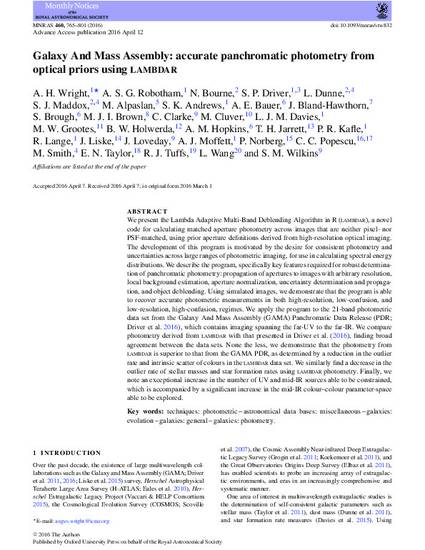
We present the Lambda Adaptive Multi-Band Deblending Algorithm in R (LAMBDAR), a novel code for calculating matched aperture photometry across images that are neither pixel- nor PSF-matched, using prior aperture definitions derived from high-resolution optical imaging. The development of this program is motivated by the desire for consistent photometry and uncertainties across large ranges of photometric imaging, for use in calculating spectral energy distributions. We describe the program, specifically key features required for robust determination of panchromatic photometry: propagation of apertures to images with arbitrary resolution, local background estimation, aperture normalization, uncertainty determination and propagation, and object deblending. Using simulated images, we demonstrate that the program is able to recover accurate photometric measurements in both high-resolution, low-confusion, and low-resolution, high-confusion, regimes. We apply the program to the 21-band photometric data set from the Galaxy And Mass Assembly (GAMA) Panchromatic Data Release (PDR; Driver et al. 2016), which contains imaging spanning the far-UV to the far-IR. We compare photometry derived from LAMBDAR with that presented in Driver et al. (2016), finding broad agreement between the data sets. None the less, we demonstrate that the photometry from LAMBDAR is superior to that from the GAMA PDR, as determined by a reduction in the outlier rate and intrinsic scatter of colours in the LAMBDAR data set. We similarly find a decrease in the outlier rate of stellar masses and star formation rates using LAMBDAR photometry. Finally, we note an exceptional increase in the number of UV and mid-IR sources able to be constrained, which is accompanied by a significant increase in the mid-IR colour–colour parameter-space able to be explored.
Wright, A. H., et al. "Galaxy And Mass Assembly: Accurate Panchromatic Photometry from Optical Priors Using LAMBDAR." 2016. Monthly Notices of the Royal Astronomical Society 460(1): 765-801.

This article has been accepted for publication in Monthly Notices of the Royal Astronomical Society Copyright: 2016. Published by Oxford University Press on behalf of the Royal Astronomical Society. All rights reserved.
https://doi.org/10.1093/mnras/stw832